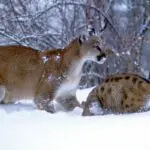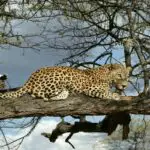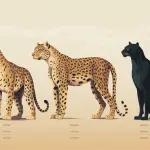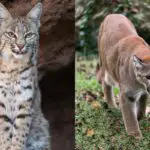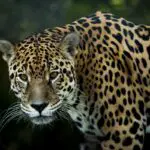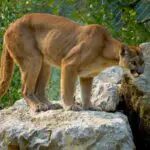“Panther” is a term that is widely used to refer to three distinct animal species. These are jaguars, leopards, and mountain lions.
Specifically, it refers to melanistic cats, with mountain lions being the outlier. This term isn’t often used for mountain lions, and is more popular for black jaguars and leopards.
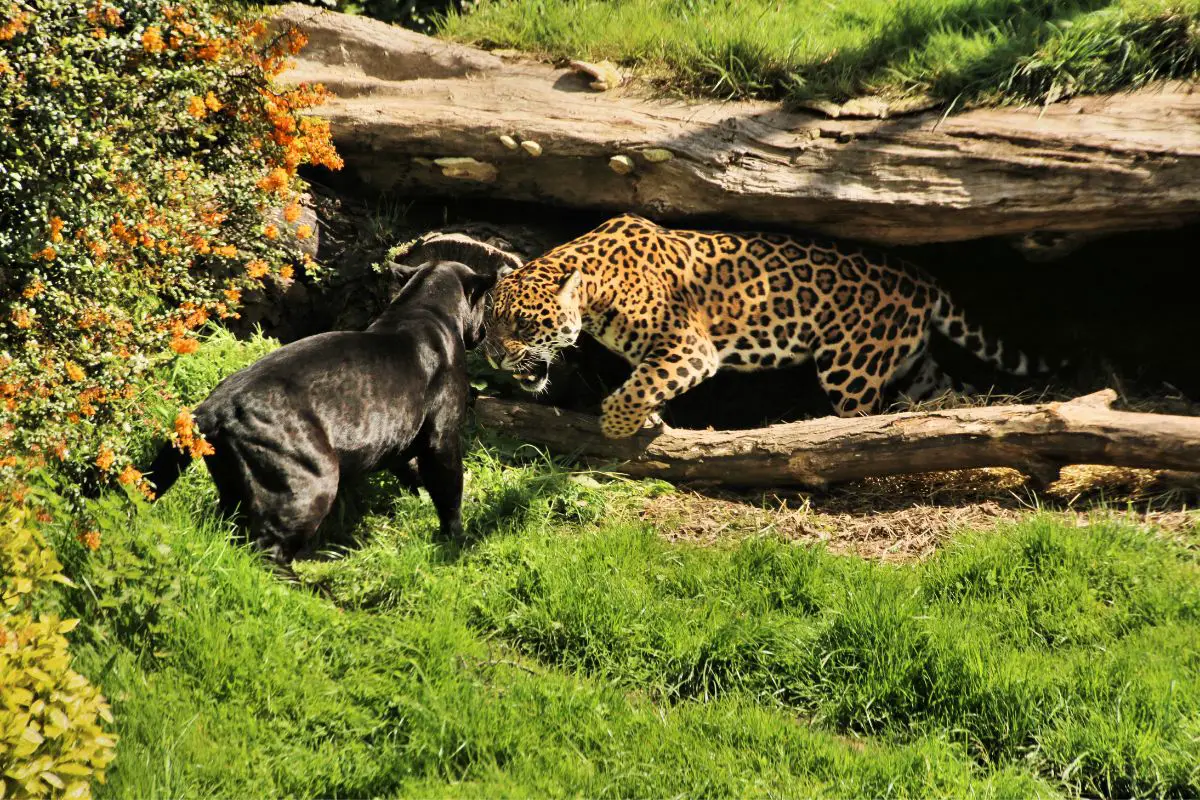
Mountain lions go by many names (and even hold the world record for the most), including panthers!
For clarity, we will be using the term “panther” to describe leopards and mountain lions, as they are being compared to jaguars. The panther section will be split in two subsections.
In this article, we are also referring to African leopards, rather than snow or clouded leopards.
Keen to find out more about these animals? Keep reading!
Panther Vs Jaguar: The Main Differences
Classification
Panther
Leopard
- Also known as: varies depending on subspecies and location
- Average lifespan in the wild: 12-17 years
- Scientific name: panthera pardus
- Genus: Panthera
- Family: Felidae
- Order: Carnivora
- Class: Mammalia
- Kingdom: Animalia
- Phylum: Chordata
- Height: 2-3 feet at the shoulder
- Weight: 60-200 lbs
- Length: 3-6.2 feet (head and body); 3.5-4.5 feet (tail)
- Conservation status: endangered
- Number of subspecies: nine
Mountain Lion
- Also known as: puma, cougar, panther, catamount, red tiger, deer tiger, painter
- Average lifespan in the wild: 10-13 years
- Scientific name: puma concolor
- Genus: Puma
- Family: Felidae
- Order: Carnivora
- Class: Mammalia
- Kingdom: Animalia
- Phylum: Chordata
- Height: 2-3 feet at the shoulder
- Weight: 64-220 lbs
- Length: 3.25-5.25 feet (head and body); 23.5-33.5 inches (tail)
- Conservation status: varies depending on subspecies, typically least concern (population decreasing)
- Number of subspecies: seven living subspecies, one extinct
Jaguar
- Also known as: Jaguar
- Average lifespan in the wild: 12-15 years
- Scientific name: panthera onca
- Genus: Panthera
- Family: Felidae
- Order: Carnivora
- Class: Mammalia
- Kingdom: Animalia
- Phylum: Chordata
- Height: 2-3 feet at the shoulder
- Weight: 220-350 lbs
- Length: 5-7 feet (head and body); 2-3 feet (tail)
- Conservation status: varies depending on subspecies, typically near threatened
- Number of subspecies: nine
Appearance And Characteristics
Panther
Leopard
Black or melanistic leopards are also known as panthers. Melanistic leopards can be various shades of black, and their rosettes are still visible but less noticeable.
Regular leopards, or ones without melanistic features, have a yellow-tan coat with black rosettes.
However, the rosettes of a leopard have no black spots inside them like the jaguar’s.
The shades of brown can vary depending on the environment they are in, such as deserts or forests.
Paler shades are usually seen in desert locations, and richer colors in rainforests, as is the case with jaguars.
In terms of size, leopards can weigh up to 200lbs, and measure 6.3 feet long.
These animals also have extremely long tails, which can be over 4 feet long. Cubs are born with blue eyes, and turn golden brown as they get older.
Mountain Lion
Mountain lions are not one of the “big cats”, despite the fact that they are large.
At the shoulder, these animals only usually reach around 3 feet. They have bodies that reach lengths of around 5 feet, and their tails can be between 23 and 33 inches long.
From the nose to the tip of the tail, a mountain lion can measure up to 7.7 feet long, and they can weigh up to 220 lbs.
Their color can vary depending on their location in the Americas. They will always be a shade of tan or a tawny brown, unless they have a mutation.
Mountain lions will also have a few minor black markings. These markings will be around the animal’s snout, the tips of their ears, and the tip of their tail.
Cubs have more black markings than adults, including black spots to aid them with blending into the surroundings.
Adults have eyes that can appear to be a green-brown or yellow color, while cubs have blue eyes.
Jaguar
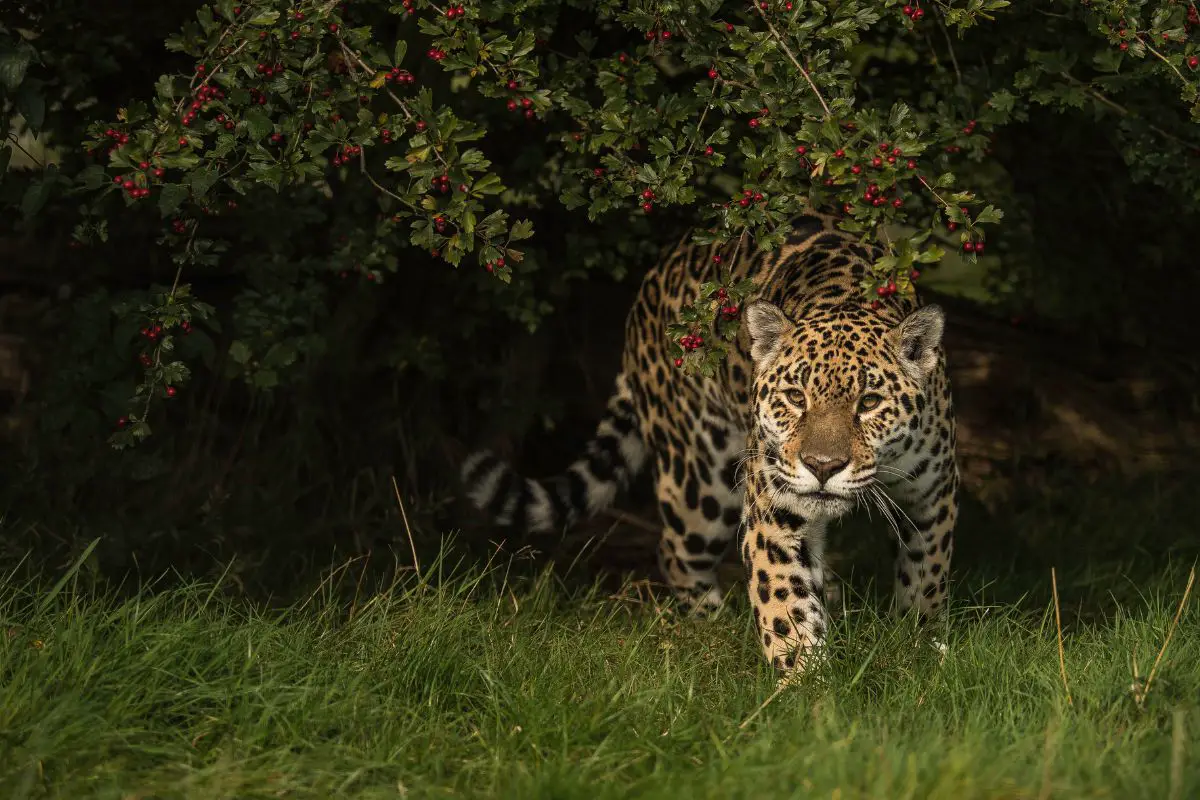
Black jaguars are often referred to as panthers. Regular jaguars have stunning yellow-tan coats with bold, black rosettes with a spot in the middle.
Shades of this tan will vary depending on location, as jaguars in the rainforest typically have brighter coats.
Weighing between 220-350lbs, jaguars are considerably larger than both leopards and mountain lions.
These animals typically stand at 3 feet at the shoulder and can reach lengths of 5-7 feet from their note to the base of their tail.
The tail can add another 2-3 feet, making a total length of 9-10 feet.
Melanistic jaguars have beautiful black coats that come in various shades. Some animals have fur that looks almost completely black, while others have lighter patches.
In either case, these animals still have their unique rosettes, but they are not always noticeable unless in the right lighting.
Sounds And Calls
Panther
Leopard
Leopards are known to make a variety of sounds, some of which are similar to the jaguar.
Like other big cats, they can’t purr, but will grunt, usually in greeting, and growl when they are threatened. Leopards will also hiss when they feel threatened, and meow.
Like jaguars, leopards also have a saw-like sound, which is their long-distance call and common occurrence.
These animal’s roars are very low, almost baritone, and sound hoarse.
Mountain Lion
Mountain lions can make a range of sounds, but they can’t roar like big cats such as jaguars and leopards.
A mountain lion will growl and hiss, much like a house cat, and they can also purr.
Both males and females are known for their “scream” that can often be heard in the wilderness. This sounds remarkably like a woman screaming.
Jaguar
Jaguars are very vocal animals, but can’t purr like mountain lions can.
They are known to make a range of noises, including roaring, mewing, and grunting.
The most notable sound a jaguar makes, however, is known as “sawing” – aptly named, as it sounds like a saw working through a block of wood!
When jaguars greet each other, they will also make a nasally snuffling noise, which is also thought to be used to reassure each other.
Happy jaguars may start “chuffing” to express themselves.
Family
Panther
Leopard
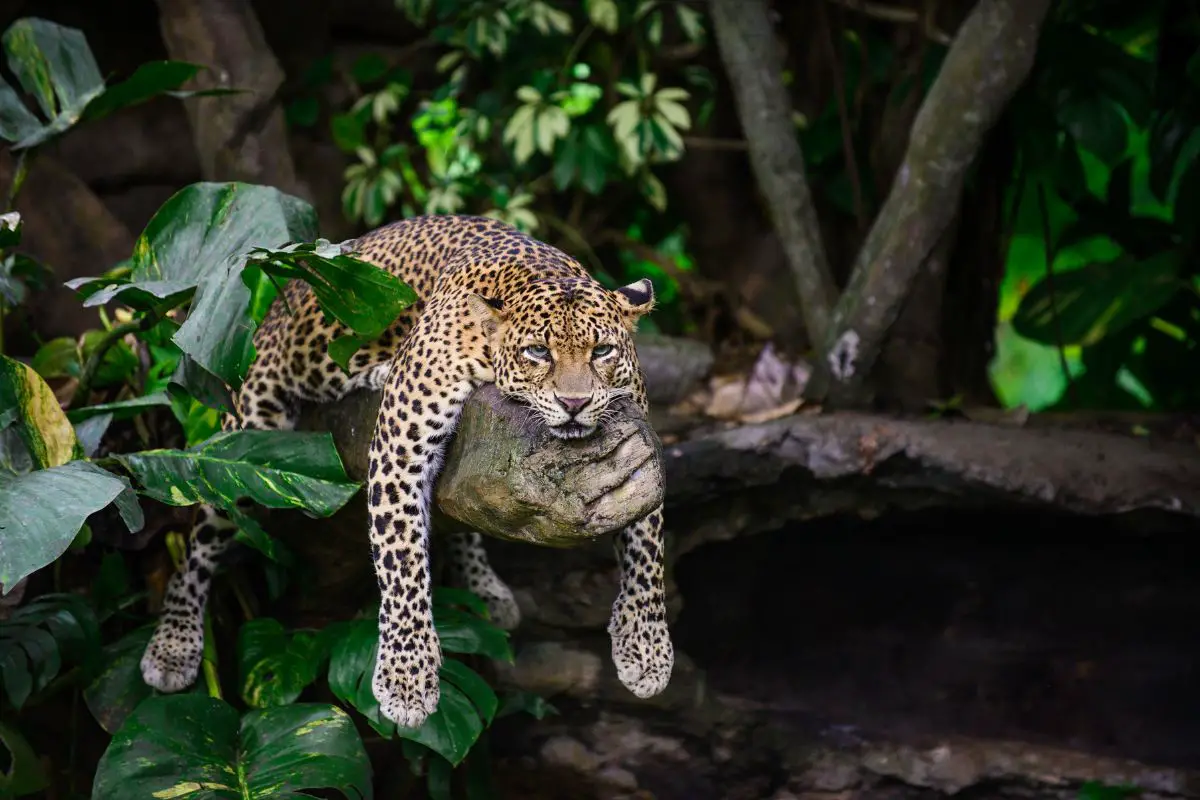
Leopards are in the Felidae family, too, so they are cats.
Mountain Lion
Mountain lions are also part of the Felidae family.
Jaguar
Jaguars are members of the Felidae, or cat, family.
Habitats And Range
Panther
Leopard
These animals are found in a wide variety of habitats, including sub-Saharan desert regions, grasslands, wetlands, and rainforests.
Leopards are actually the most widespread of all big cats, and are found in Africa, Asia, and Europe.
Many leopards also do well in mountainous and snowy regions, primarily in Asia and Europe.
Like the jaguar, they are capable of adapting to new surroundings as long as there is prey and shelter in the area.
Mountain Lion
Mountain lions cover a large range – all the way from Alaska to Argentina and southern Chile.
Because of this, they can thrive in a variety of ecosystems as long as there is prey and shelter at their disposal.
Many mountain lions thrive in forests, deserts, wetlands, and mountainous regions.
Mountain lions like to avoid human contact, as most animals do.
However, they have been seen in city suburbs and towns that have been built onto their territory.
In the United States, the majority of the mountain lion population lives in states like California.
Jaguar
Jaguars can do well in a variety of habitats, including arid scrubland, grasslands, tropical forests and rainforests, mangroves, swamps, mixed conifer forests, and lowland river valleys.
As such, they are good at adapting to new surroundings, which is why they have managed to survive in places like Arizona.
These animals are only found in Central and South America, with a few exceptions in the southernmost states of the United States, like Arizona.
They primarily live in rainforests like the Amazon, or wetlands like the Pantanal. In fact, the Amazon basin is home to the largest populations of jaguars in the world!
Social Behavior
Panther
Leopard
Leopards are solitary animals and only spend time with others when mating or caring for their cubs.
The size of these animals’ territory can vary greatly, from as little as a few square miles to a hundred square miles, depending on the available prey.
Mountain Lion
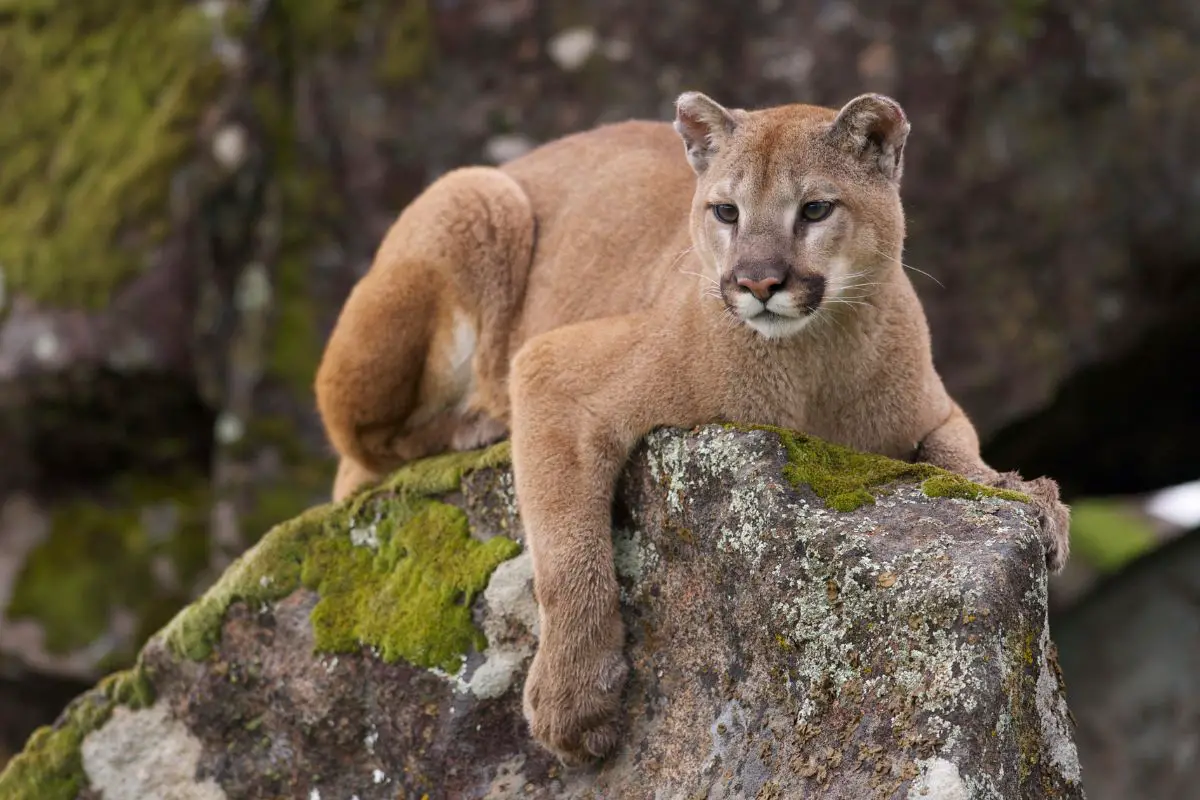
Mountain Lions are solitary animals. This means that they live alone and have their own territories.
The only time that these animals don’t live alone is during the mating season and when the female is caring for her cubs.
When solitary, these animals need between 50 and 125 square miles to roam, with males preferring more space.
Jaguar
Jaguars are solitary animals for the majority of their lives. The only time they are not alone is during the mating season and when females are raising their cubs.
These animals typically only need between 10-50 square miles of territory in order to be happy.
However, territory sizes vary depending on where the animal is located.
Diet
Panther
Leopard
Leopards are obligate carnivores. This means that they can only get the nutrients they need from meat rather than vegetation.
Leopards will primarily prey on antelope such as impala, bushbuck, and kudu.
They are famous for pulling their catches into trees to keep it away from lions, hyenas, and other carnivores that are not capable climbers.
Mountain Lion
Mountain lions are obligate carnivores. This means that they can only get the nutrients they need from meat rather than vegetation.
Mountain lions will typically hunt for things like deer or sheep, but will also eat smaller animals like mice, insects, and rabbits when available.
Jaguar
Jaguars are obligate carnivores. This means that they can only get the nutrients they need from meat rather than vegetation.
Popular jaguar prey include tapirs, caiman, capybaras, and deer. They are also excellent at fishing and frequently have diets that are rich in fish.
Breeding
Panther
Leopard
Females reach sexual maturity at 2-2 ½ year old, and males at 1 ½ years old.
These animals don’t have a defined breeding season, and mating can happen at any time of year.
Females will give birth to litters with 2-6 cubs after their 90-105 days of gestation.
She will then care for her cubs, who could remain with her for up to two years before they are able to care for themselves and leave.
Mountain Lion
Mountain lions don’t have a set mating season, either, and mating can happen at any point of the year.
Most cougar births take place between late winter and spring, however. Females will breed every two years once they reach sexual maturity.
These animals have a gestation period of 90 to 96 days, then will give birth to 1-5 cubs.
These cubs will stay with her until they are ready to live on their own. This is typically after 1-2 years, once they have learned how to effectively hunt and care for themselves.
Jaguar
Jaguars will only reach sexual maturity when they are 2-3 years old. From then, they will breed every two years and produce litters of 2-4 cubs.
Like leopards and mountain lions, jaguars have no set breeding season.
They have a gestation period of around 100 days, then the cub will remain with the mother until they are ready to take care of themselves.
Who Would Win In A Fight?
Based on its size and strength, the jaguar would win a fight against a leopard or a mountain lion. While all three are strong, jaguars would take the cake.
Final Thoughts
Although these three animals are all large cats, there are some big differences between them.
The biggest difference to note is the range. Leopards are found across three continents and have the biggest range of all big cats.
Jaguars and mountain lions are both only found in the Americas.
The appearances are also worth noting. Both leopards and jaguars have rosettes, and mountain lions have no notable markings.
The jaguar is also a much larger and muscular animal compared to both leopards and mountain lions!
- Sink Your Teeth Into This: Analyzing the Powerful Lion Bite Force - September 8, 2023
- Siberian Tigers: Everything You Need To Know - September 4, 2023
- Do Lions Eat Humans? Understanding Lion Aggression and Risks - September 4, 2023



